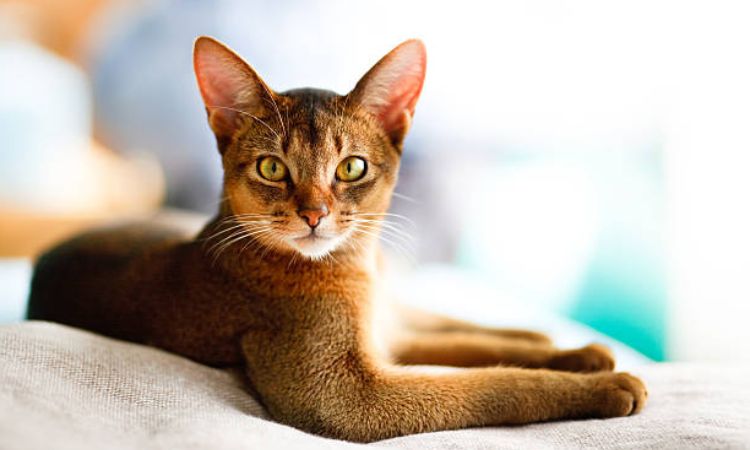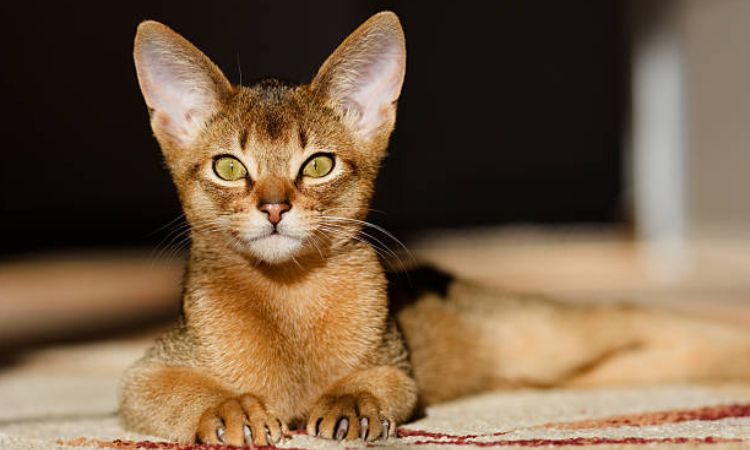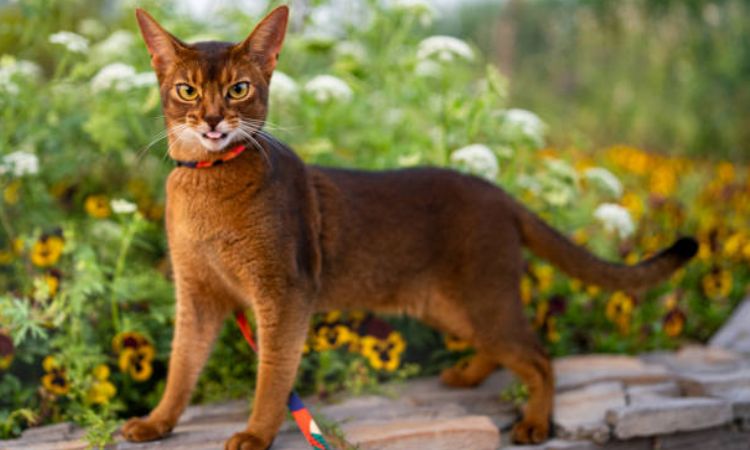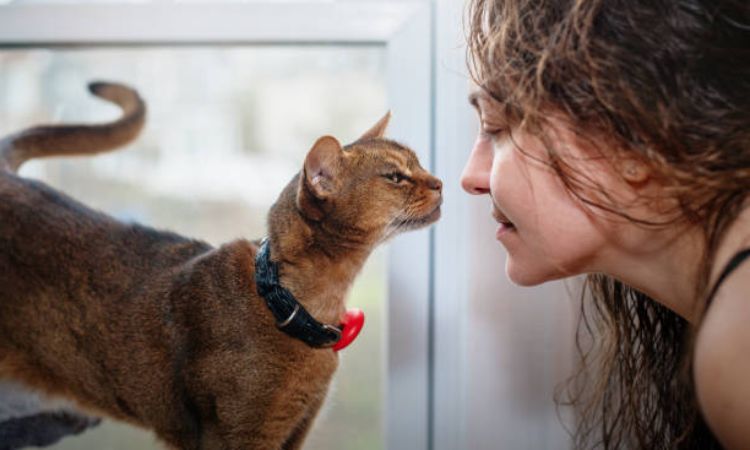With a sleek, athletic frame and eyes that seem to sparkle with curiosity, the Abyssinian is a cat that instantly captures attention. Known for their playful intelligence and boundless energy, these ancient felines have been charming humans for centuries.
Join Nexus Pets as we explore everything you need to know about the Abyssinian its size, origins, appearance, behavior and health in this ultimate guide to one of the most captivating cat breeds in the world.
Abyssinian Cat Overview and History
The Abyssinian cat is often affectionately called an “Aby”. This shorthand reflects the breed’s popularity and familiarity among cat enthusiasts. Some cat lovers also playfully refer to them as the “Aby-silly-an” or the “clowns of the cat kingdom”, highlighting their energetic, playful, and sometimes mischievous nature.

Breed Origin
Ancient Roots and Mythology
The Abyssinian is often associated with ancient Egypt, where cats resembling the modern Aby have been depicted in sculptures, paintings, and carvings. These images show slender, active cats with ticked coats, suggesting that the breed’s ancestors may have lived among pharaohs and ancient Egyptian households. This has contributed to the breed’s exotic and “wildcat” reputation, though concrete evidence linking them directly to Egypt remains uncertain.
Modern Origin Debate
The breed’s name, Abyssinian, suggests a connection to Abyssinia (modern-day Ethiopia). According to one popular story, British soldiers returning from the Abyssinian War in the 19th century brought back kittens to Europe. However, recent research and genetic studies point to a more complex origin: the Abyssinian likely descended from cats native to the coastal regions of the Indian Ocean and parts of Southeast Asia, rather than Africa. Supporting this theory is the discovery of a taxidermied cat purchased in the early 1800s, labeled “Patrie, domestica India,” indicating an Asian origin. These findings align with modern DNA studies, which trace Aby ancestry to both Southeast Asian and Western domestic cats.
Formal Recognition in the West
The Abyssinian was formally introduced to England in the late 19th century, with one of the earliest known show cats being “Zula,” exhibited at the Crystal Palace show in 1871. The breed faced near extinction in the UK following World War II and an outbreak of feline leukemia, prompting breeders to import Abyssinians from Europe, the United States, and other regions to restore the population. Abyssinians were officially recognized by major cat associations, including the CFA (Cat Fanciers’ Association) in 1906, and have since become one of the most popular and admired short-haired cat breeds worldwide.
Abyssinian Size and Lifespan
- Size/Weight: Medium-sized cats, with adult males weighing 8–12 pounds (3.6–5.4 kg) and females slightly smaller at 6–10 pounds (2.7–4.5 kg).
- Height: Typically 8–10 inches (20–25 cm) at the shoulder.
- Lifespan: Generally 12–17 years, though many Abyssinians live healthy lives beyond this range when provided proper care and nutrition.
The Abyssinian’s unique combination of ancient mystique, athletic build, and sociable personality has earned it a special place among cat lovers, making it one of the most striking and beloved breeds in the world.
Physical Appearance of the Abyssinian Cat
Body Build and Structure
The Abyssinian has a medium-sized, lean, and athletic body with a graceful yet muscular build that gives it an elegant, almost regal presence. Their stance often makes them appear as though they’re standing on tiptoe, thanks to their slender, long legs and small, oval-shaped paws. Despite their refined frame, they feel surprisingly solid and muscular when held, reflecting their active and agile nature.
Distinctive Head and Facial Features
Abyssinians have a modified wedge-shaped head that complements their streamlined body. One of their most striking features is their large, upright ears, which sit alertly on the head and give them an inquisitive look.
Their eyes are large, almond-shaped, and highly expressive, often described as luminous or captivating. Depending on coat color, the eyes may appear in gold, green, hazel, or copper, sometimes with a blend between shades. Many Abyssinians also display a subtle tabby-style “M” marking on the forehead, a nod to their agouti coat genetics.

Coat and Color
The Abyssinian’s coat is one of its most iconic traits:
- Coat Type: The fur is short, dense, fine, and close-lying to the body. It has a soft texture and minimal shedding, giving the breed a smooth, polished look.
- Unique Pattern – The Ticked (Agouti) Coat: Instead of stripes or spots, each hair is banded with alternating light and dark pigment, typically three to four bands per strand. This creates a shimmering, multi-tonal effect that resembles wild felines like cougars or mountain lions. The ticking gives the Abyssinian its distinctive “wildcat” appearance.
- Common Coat Colors: The primary recognized colors include:
- Ruddy (Usual/Tawny): A warm reddish-brown with black or dark brown ticking
- Red (Sorrel/Cinnamon): Coppery or reddish base with chocolate ticking
- Blue: Soft bluish-gray base with darker slate ticking
- Fawn: Pale beige base with warm mushroom-colored ticking
Some registries also recognize additional shades like chocolate, lilac, and silver, but the four above are the most widely established.
Abyssinian Cat Behavior and Personality
1. Temperament and Intelligence
Abyssinians are one of the most mentally sharp and emotionally expressive cat breeds. They’re naturally curious, clever, and always “on,” observing and investigating everything in their environment. Their energetic antics and goofy charm have earned them nicknames like “Clowns of the Cat Kingdom” and the playful “Aby-silly-an.”
Despite their high energy, they’re not aloof—Abyssinians are incredibly people-focused and often form strong bonds with their families. They thrive on companionship and dislike being left out of household activities. Emotionally, they’re affectionate without being clingy, and they enjoy being near their humans rather than sitting still on laps.
2. Activity and Engagement Needs (The “Dog-Like” Cat)
If there’s a feline counterpart to a working dog, it’s the Abyssinian. These cats retain a kitten-like zest for life well into adulthood and are constantly on the move.
They’re known for:
- Fetching toys and bringing them back like a retriever
- Learning tricks with ease due to their intelligence and motivation
- Exploring every inch of their surroundings
To keep them mentally and physically satisfied, they need dynamic environments, ideally with:
- Tall cat trees and shelves for climbing
- Vertical spaces to perch and observe
- Interactive toys and puzzle feeders
- Daily engagement with people or other pets
Without proper stimulation or attention, Abyssinians can quickly become restless or destructive, flipping objects, opening cabinets, or inventing their own “activities.”
3. Vocalization and Interaction
Unlike some vocal breeds, Abyssinians are not excessive talkers. Instead of loud meows, they often communicate with a soft chirp or trill, especially when greeting people or asking for attention.
Their real communication style is physical and interactive:
- They tend to follow their owners room to room like loyal shadows
- They’re famous for using their paws to tap, grab, or hook objects—an endearing trait often called “Aby-grabbys”
- They watch and mimic human behavior, showing interest in everything from doors and faucets to books and keyboards
In short, living with an Abyssinian feels less like owning a cat and more like sharing space with a mischievous, playful friend who always wants to be part of the moment.

Health and Care Guide for the Abyssinian Cat
1. Grooming and Maintenance
Abyssinians are one of the easier breeds to care for when it comes to grooming. Their short, fine coat doesn’t mat easily and sheds only moderately, requiring minimal upkeep.
- Shedding: Light to moderate; most owners find very little fur around the home.
- Brushing: A quick weekly brushing is usually enough to remove loose hairs and keep the coat sleek and healthy.
- Nail Trimming: Trim claws regularly—every 1–2 weeks—to prevent overgrowth and damage to furniture.
- Dental Care: Dental hygiene is essential. Routine tooth brushing or dental treats can help prevent periodontal disease. Ear and eye checks should also be part of their regular care routine.
2. Nutritional Needs
Abyssinians are high-energy cats that burn calories quickly, so their diet needs to support their active lifestyle.
- Diet Type: High-quality, protein-rich food is recommended to sustain muscle tone and energy levels. Meat-based commercial diets that meet AAFCO standards work best.
- Obesity Risk: Abyssinians are typically too active to become overweight, but portion control and measured feeding are still important.
- Feeding Strategy: Puzzle feeders or scheduled meals can provide both stimulation and proper nutrition.
3. Common Abyssinian Health Issues (Genetic Predispositions)
Though generally healthy, Abyssinians are susceptible to several inherited conditions. Responsible breeding and early detection are key.
Hereditary Conditions:
- Pyruvate Kinase (PK) Deficiency:
A metabolic disorder caused by insufficient pyruvate kinase enzyme. It can lead to intermittent or chronic anemia. Symptoms may include weakness, lethargy, pale gums, or decreased stamina. - Progressive Retinal Atrophy (PRA):
Specifically photoreceptor dysplasia in Abyssinians. The retina fails to develop normally in kittenhood, often causing blindness within months of birth. Vision loss is irreversible, but affected cats can live fulfilling lives with accommodation. - Renal Amyloidosis:
A buildup of amyloid proteins in organs—most commonly the kidneys. This can lead to kidney dysfunction or failure. Signs include increased thirst and urination, weight loss, dull coat, and lethargy.
Other Potential Concerns:
- Dental Disease:
Tartar buildup, gingivitis, and tooth resorption can occur without proper oral care. - Psychogenic Alopecia:
Stress-related overgrooming that results in hair thinning or bald patches. - Feline Hyperesthesia Syndrome:
A neurological condition characterized by sudden twitching or sensitivity along the spine, excessive grooming, or erratic behavior.

4. Veterinarian Visits and Preventive Care
Regular vet check-ups are vital for catching health issues early and maintaining long-term wellness.
- Routine Exams: Annual visits for adults and biannual check-ups for senior cats help monitor weight, dental health, and organ function.
- Genetic Testing: Reputable breeders should screen for PRA, PK deficiency, and amyloidosis risk in breeding cats. Request proof of testing when selecting a kitten.
- Early Detection: Bloodwork, urinalysis, and eye exams can identify kidney issues, anemia, or retinal disease before symptoms become severe.
- Vaccinations and Parasite Prevention: Stay up to date to protect against common feline diseases and parasites.
The Abyssinian’s charm lies in the way beauty, intelligence, and athletic energy come together so effortlessly. From its ancient roots and striking ticked coat to its curiosity-driven personality and genetic health considerations, this breed offers a unique blend of elegance and engagement. For anyone drawn to an active, people-oriented companion with a regal look and playful spirit, the Abyssinian stands out as a captivating choice.






